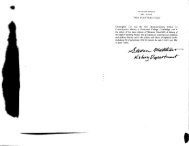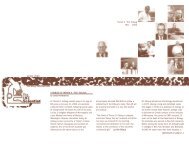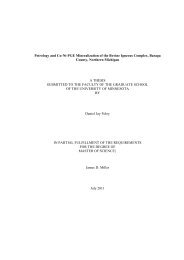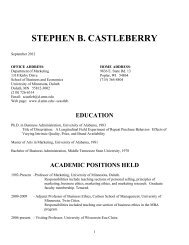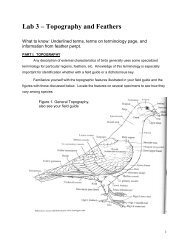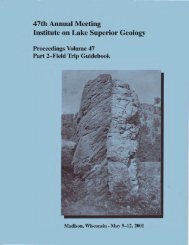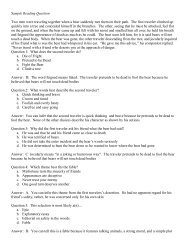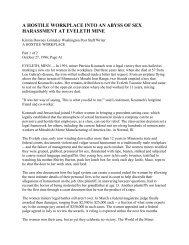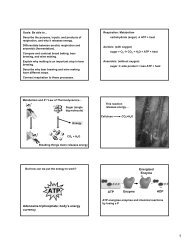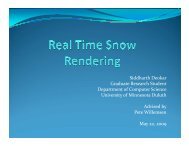Program, Abstracts, and Guidebooks - University of Minnesota Duluth
Program, Abstracts, and Guidebooks - University of Minnesota Duluth
Program, Abstracts, and Guidebooks - University of Minnesota Duluth
Create successful ePaper yourself
Turn your PDF publications into a flip-book with our unique Google optimized e-Paper software.
To<br />
-92—<br />
DESCRIPTION OF STOPS<br />
The town <strong>of</strong> Marathon is at one <strong>of</strong> the few naturally protected<br />
harbours along this part <strong>of</strong> the North shore <strong>of</strong> Lake Superior.<br />
An extensive s<strong>and</strong> <strong>and</strong> gravel deposit underlies the townsite<br />
<strong>and</strong> extends eastward to Heron Bay <strong>and</strong> northward approximately 2½<br />
miles. +<br />
the north these s<strong>and</strong> <strong>and</strong> gravel deposits are seen to<br />
overlay broad terrace <strong>of</strong> varved clays which trends parallel to<br />
the present course <strong>of</strong> the Big Pie River for more than 50 miles<br />
(Farr<strong>and</strong>, 1960).<br />
There are at least six beach terraces at Marathon (Thomson,<br />
1934; Puskas, 1964). The highest beach is 710 feet above Mean<br />
Sea Level or 108 feet above the present surface <strong>of</strong> Lake Superior<br />
(Hough, 1958). The vertical interval between these beach terraces<br />
is 5 to 45 feet. Walker (1956) states that the vertical interval<br />
between terraces occurring 20 or more miles to the west is 5 to<br />
10 feet. These differences may indicate a relative increase in<br />
the rate <strong>of</strong> post glacial isostatic adjustment to the east in dir—<br />
ection <strong>of</strong> the Marathon area.<br />
qae<br />
0.0 Intersection <strong>of</strong> Highway 17 <strong>and</strong> turn <strong>of</strong>f to Marathon.<br />
Continue south east on Highway 17.<br />
2.4 Eastern contact <strong>of</strong> Massif with country rock.<br />
STOP 1 (Fig. 1 & 2) is a 2 mile traverse across the eastern part<br />
<strong>of</strong> the massif beginning at the contact <strong>of</strong> gabbro <strong>and</strong><br />
anatexite. (Fig. 2)<br />
Because <strong>of</strong> the close proximity <strong>of</strong>, the country rocks<br />
to a considerable portion <strong>of</strong> the traversed gabbros, the<br />
gabbros are highly charged with xenoliths, variably assimilated,<br />
<strong>and</strong> variably hybridized.<br />
STOP1A EASTERN CONTACT OF MASSIF (Fig. 2).<br />
The local contact zone between gabbro, occurring as<br />
a topographic 'high', <strong>and</strong> anatex±tes shows the following<br />
features;<br />
(1) in plan, the contact appears flexured<br />
or arcuate.<br />
(2) dip relations <strong>of</strong> contact indicate 'on—<br />
lap' by anatexite.




